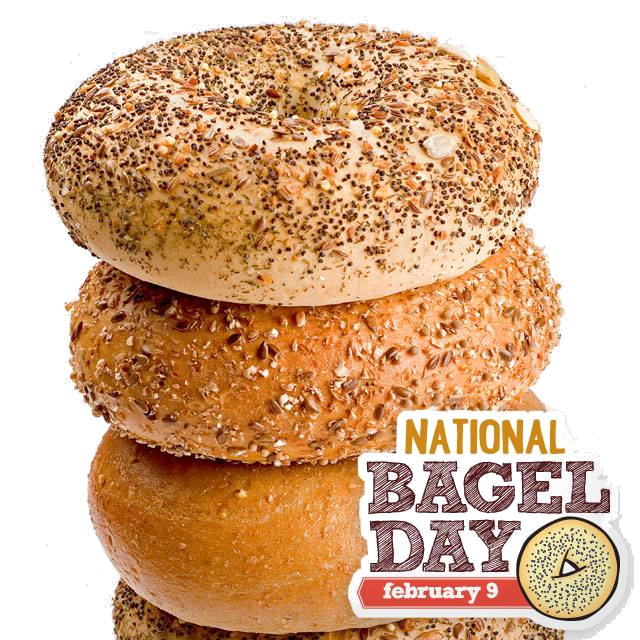Happy National Bagel Day!
February 9

National Bagel Day is celebrated on February 9th of each year.
We can thank the
Jewish population of Eastern Europe for the dense, chewy, doughy
circles of wheat that have assimilated into our western diet about as
easily as apple pie. Topped with a schmear of cream cheese, peanut
butter and just about any other sandwich filler you can think of, the
bagel is especially popular in the U.S., Canada and the United Kingdom.
A bagel (Yiddish: בײגל beygl, Polish: bajgiel), also spelled beigel, is a bread product originating in Poland, traditionally shaped by hand into the form of a ring from yeasted wheat dough, roughly hand-sized, which is first boiled for a short time in water and then baked. The result is a dense, chewy, doughy interior with a browned and sometimes crisp exterior. Bagels are often topped with seeds baked on the outer crust, with the traditional ones being poppy, sunflower or sesame seeds. Some also may have salt sprinkled on their surface, and there are also a number of different dough types, such as whole-grain or rye.

Though the origins of bagels are somewhat obscure, it is known that they were widely consumed in East European Jewish communities from the 17th century. The first known mention of the bagel, in 1610, was in Jewish community ordinances in Kraków, Poland.
Bagels are now a popular bread product in North America, especially in cities with a large Jewish population, many with different ways of making bagels. Like other bakery products, bagels are available (either fresh or frozen, and often in many flavor varieties) in many major supermarkets in those countries.
The basic roll-with-a-hole design is hundreds of years old and has other practical advantages besides providing for a more even cooking and baking of the dough: the hole could be used to thread string or dowels through groups of bagels, allowing for easier handling and transportation and more appealing seller displays.
Bagels are now a popular bread product in North America, especially in cities with a large Jewish population, many with different ways of making bagels. Like other bakery products, bagels are available (either fresh or frozen, and often in many flavor varieties) in many major supermarkets in those countries.
The basic roll-with-a-hole design is hundreds of years old and has other practical advantages besides providing for a more even cooking and baking of the dough: the hole could be used to thread string or dowels through groups of bagels, allowing for easier handling and transportation and more appealing seller displays.


History
Contrary to some beliefs, the bagel was not created in the shape of a stirrup to commemorate the victory of Poland's King John III Sobieski over the Ottoman Empire at the Battle of Vienna in 1683.
Linguist Leo Rosten wrote in The Joys of Yiddish about the first known mention of the Polish word bajgiel derived from the Yiddish word bagel in the "Community Regulations" of the city of Kraków in 1610, which stated that the item was given as a gift to women in childbirth.
Contrary to some beliefs, the bagel was not created in the shape of a stirrup to commemorate the victory of Poland's King John III Sobieski over the Ottoman Empire at the Battle of Vienna in 1683.
Linguist Leo Rosten wrote in The Joys of Yiddish about the first known mention of the Polish word bajgiel derived from the Yiddish word bagel in the "Community Regulations" of the city of Kraków in 1610, which stated that the item was given as a gift to women in childbirth.
In the 16th and first half of the 17th centuries, the bajgiel became a staple of Polish cuisine and a staple of the Slavic diet generally. Its name derives from the Yiddish word beygal from the German dialect word beugel, meaning "ring" or "bracelet".



Variants of the word beugal are used in Yiddish and in Austrian German to refer to a similar form of sweet-filled pastry (Mohnbeugel (with poppy seeds) and Nussbeugel (with ground nuts), or in southern German dialects (where beuge refers to a pile, e.g., holzbeuge "woodpile"). According to the Merriam-Webster dictionary, 'bagel' derives from the transliteration of the Yiddish 'beygl', which came from the Middle High German 'böugel' or ring, which itself came from 'bouc' (ring) in Old High German, similar to the Old English bēag "ring" and būgan "to bend, bow". Similarly, another etymology in the Webster's New World College Dictionary says that the Middle High German form was derived from the Austrian German beugel, a kind of croissant, and was similar to the German bügel, a stirrup or ring.
In the Brick Lane district and surrounding area of London, England, bagels (or, as locally spelled, "beigels") have been sold since the middle of the 19th century. They were often displayed in the windows of bakeries on vertical wooden dowels, up to a metre in length, on racks.
Bagels with cream cheese and lox (cured salmon) are considered a traditional part of American Jewish cuisine (colloquially known as "lox and a schmear").

Bagels were brought to the United States by immigrant Polish Jews, with a thriving business developing in New York City that was controlled for decades by Bagel Bakers Local 338, They had contracts with nearly all bagel bakeries in and around the city for its workers, who prepared all their bagels by hand.
The bagel came into more general use throughout North America in the last quarter of the 20th century with automation. Daniel Thompson started work on the first commercially viable bagel machine in 1958; bagel baker Harry Lender, his son, Murray Lender, and Florence Sender leased this technology and pioneered automated production and distribution of frozen bagels in the 1960s.Murray also invented pre-slicing the bagel.
Around 1900, the "bagel brunch" became popular in New York City. The bagel brunch consists of a bagel topped with lox, cream cheese, capers, tomato, and red onion. This and similar combinations of toppings have remained associated with bagels into the 21st century in the US.
In Japan, the first kosher bagels were brought by BagelK (ja) from New York in 1989. BagelK created green tea, chocolate, maple-nut, and banana-nut flavors for the market in Japan. There are three million bagels exported from the U.S. annually, and it has a 4%-of-duty classification of Japan in 2000. Some Japanese bagels, such as those sold by BAGEL & BAGEL (ja), are soft and/or sweet; others, such as Einstein Bro. bagels sold by Costco in Japan, are the same as in the U.S.
The bagel came into more general use throughout North America in the last quarter of the 20th century with automation. Daniel Thompson started work on the first commercially viable bagel machine in 1958; bagel baker Harry Lender, his son, Murray Lender, and Florence Sender leased this technology and pioneered automated production and distribution of frozen bagels in the 1960s.Murray also invented pre-slicing the bagel.
Around 1900, the "bagel brunch" became popular in New York City. The bagel brunch consists of a bagel topped with lox, cream cheese, capers, tomato, and red onion. This and similar combinations of toppings have remained associated with bagels into the 21st century in the US.
In Japan, the first kosher bagels were brought by BagelK (ja) from New York in 1989. BagelK created green tea, chocolate, maple-nut, and banana-nut flavors for the market in Japan. There are three million bagels exported from the U.S. annually, and it has a 4%-of-duty classification of Japan in 2000. Some Japanese bagels, such as those sold by BAGEL & BAGEL (ja), are soft and/or sweet; others, such as Einstein Bro. bagels sold by Costco in Japan, are the same as in the U.S.

Bagel Styles
Two of the most well-known varieties of bagels are the Montreal and New York styles. The Montreal style has malt and sugar and no salt. It’s boiled in honey-sweetened water and then baked in a wood-fired oven. The New York style has salt and malt and is boiled in water before being baked in a standard oven. The New York bagel is puffier and has a smaller hole than its Montreal counterpart. Montreal bagels are sweeter and less dense. They’re also crispy on the outside and chewy on the inside.
While fresh bagels of any style are most delicious, eating too many of them could spell weight gain. One bagel contains about 56 grams of carbohydrates or 300 calories – and that’s before you add the cream cheese!
What makes bagels so unique besides their characteristic shape is the fact that they are boiled before they’re baked. This gives bagels their distinctive taste, chewy texture and shine. Recently, the boiling process has been replaced with a steam process, which requires less labor and is favored by manufacturers but not by bagel purists, who say the quality is subpar.
Two of the most well-known varieties of bagels are the Montreal and New York styles. The Montreal style has malt and sugar and no salt. It’s boiled in honey-sweetened water and then baked in a wood-fired oven. The New York style has salt and malt and is boiled in water before being baked in a standard oven. The New York bagel is puffier and has a smaller hole than its Montreal counterpart. Montreal bagels are sweeter and less dense. They’re also crispy on the outside and chewy on the inside.
While fresh bagels of any style are most delicious, eating too many of them could spell weight gain. One bagel contains about 56 grams of carbohydrates or 300 calories – and that’s before you add the cream cheese!
What makes bagels so unique besides their characteristic shape is the fact that they are boiled before they’re baked. This gives bagels their distinctive taste, chewy texture and shine. Recently, the boiling process has been replaced with a steam process, which requires less labor and is favored by manufacturers but not by bagel purists, who say the quality is subpar.



Bagel Trivia:
Bagels have made their way to outer space thanks to Canadian-born astronaut Gregory Chamitoff. He’s the first space monkey to have taken a batch of 18 sesame seed bagels into space on his 2008 Space Shuttle mission to the International Space Station.
Freeze bagels as soon after purchase as possible, using a heavy air-tight bag with the air squeezed out of it. Freezing a stale bagel won’t magically make it not stale, so freeze when fresh. Day- or two-old bagels can be popped in the micro wave for a few seconds to refresh them. Be sure to wrap it in a moistened paper towel before zapping.
Believe it or not, it’s said a frozen bagel will help a crying, teething baby. Considered a safe and healthy teething ring, a frozen bagel must be carefully watched to ensure it doesn’t thaw enough so that bits are bitten off and swallowed.
The biggest bagel ever was created by Bruegger’s Bagels at the New York State Fair in Syracuse, New York in 2004. It weighed 868 pounds, was six feet in diameter and nearly 20 inches thick.
Ben & Jerry originally considered getting into the bagel business, but the equipment was too expensive.
Bagels have made their way to outer space thanks to Canadian-born astronaut Gregory Chamitoff. He’s the first space monkey to have taken a batch of 18 sesame seed bagels into space on his 2008 Space Shuttle mission to the International Space Station.
Freeze bagels as soon after purchase as possible, using a heavy air-tight bag with the air squeezed out of it. Freezing a stale bagel won’t magically make it not stale, so freeze when fresh. Day- or two-old bagels can be popped in the micro wave for a few seconds to refresh them. Be sure to wrap it in a moistened paper towel before zapping.
Believe it or not, it’s said a frozen bagel will help a crying, teething baby. Considered a safe and healthy teething ring, a frozen bagel must be carefully watched to ensure it doesn’t thaw enough so that bits are bitten off and swallowed.
The biggest bagel ever was created by Bruegger’s Bagels at the New York State Fair in Syracuse, New York in 2004. It weighed 868 pounds, was six feet in diameter and nearly 20 inches thick.
Ben & Jerry originally considered getting into the bagel business, but the equipment was too expensive.



No comments:
Post a Comment